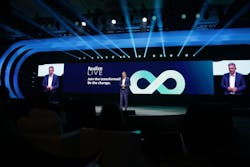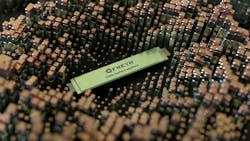Siemens Leans into SaaS, the Metaverse and SMBs
In early 2022, Siemens announced that it was transforming itself into “a tech company” as marked by a concentrated focus on delivering its technologies as a service and expanding its customer base among small to mid-sized businesses (SMBs). A little more than a year since that announcement, the company highlighted its moves over the past year to fulfill its tech company goals.
During the media and analyst program held as part of the Siemens’ Realize Live 2023 event, Tony Hemmelgarn, president and CEO of Siemens Digital Industries Software, said that in the second quarter of 2023, Siemens grew by 15% (to 19.4 billion euros) with the Digital Industries group growing 23% to 5.5 billion euros. This is “the highest ever quarterly earnings” for the group, he added.
Discher said these factors are causing businesses of all sizes to realize that today it’s “about how fast can you become more resilient by digitalizing to improve your clock speed and quickly deliver a return on investment.”
This is why Siemens has spent billions integrating its software and automation portfolio, Discher added, connecting its mechanical, electrical and software technologies to enable a complete digital twin in Xcelerator—Siemens platform that now spans every industry Siemens serves: infrastructure, mobility and industrial.
Metaverse update
In June 2022, Siemens announced a partnership with Nvidia using digital twin technology and artificial intelligence (AI) to create an industrial metaverse as an extension of its Xcelerator portfolio. At the Realize Live event, Siemens highlighted a cloud-based digital twin of the next-generation giga factories planned by Freyr Battery, a Norway-based battery cell manufacturer for electric vehicle and marine use. Founded in 2018, Freyr produces batteries using renewable energy sources and plans to rapidly scale its production capabilities while maintaining its sustainable production operations.
The company has already begun building the first of its planned giga factories in Mo i Rana, Norway, and announced potential development of industrial scale battery cell production in Vaasa, Finland, as well as the United States. Freyr says it intends to install 50 GWh of battery cell capacity by 2025, 100 GWh annual capacity by 2028 and 200 GWh of annual capacity by 2030.
As Hemmelgarn highlighted Siemens’ work with Freyr, he called out a key difference in the metaverse and its underlying digital twin technologies that potential users should be aware of. “One of the problems when people talk about the metaverse is they'll say ‘we have this wonderful simulation.’ But when you dig into it, it's not really simulation—it's an animation.”
Hemmelgarn said this animation/simulation misunderstanding can bring into question whether or not there’s a “digital twin or any physics-based solutions behind it.” He stressed that what Siemens is showing is “not a movie—it's like a gaming engine. You can go wherever you want in this factory to see, for example, the operational effectiveness of it. I can zoom into an area and look at a particular machine and see all the metrics about what's happening with this machine. With a robot, if there’s a problem with it, I can go to its digital twin and actually see the design and make changes to it based on what's happening.”
Freyr is currently using several Siemens Industrial Operations X technologies (part of the Xcelerator portfolio) across its entire battery design and manufacturing process. These technologies include product lifecycle management (PLM), manufacturing execution systems (MES), industrial edge computing, and IT/OT connectivity. According to Freyr, Siemens Industrial Operation X will help them better connect design and manufacturing to scale-up production and speed their progress towards development of the planned giga factories. (A video demonstrating Siemens and Nvidia’s metaverse is posted at the end of this article.)
Startup success
With SMBs becoming a larger component of Siemens’ customer base, the company spent a great deal of time at its annual Realize Live event focusing on how Teamcenter X—the SaaS version of its Teamcenter lifecycle management software—is well suited for such companies due to its delivery of a 55% cost savings over an on-premises deployment. This cost reduction associated with SaaS versus on-premises applies to both SMBs and large companies, according to Hemmelgarn.
Jones added that about 25% of Siemens cloud revenue this past year came from the aerospace and defense sector—an industry vertical that Siemens thought wouldn’t move aggressively to the cloud for a variety of IP and security concerns. With many of these concerns allayed by continuously updated security methods managed by the provider, cloud software use is quickly becoming the norm across industry.
According to Siemens, Regent has been using the Xcelerator portfolio as its design, engineering and development toolset since Regent’s founding in 2020.
“Regent wants to change the way you move by drastically reducing the cost and time to move goods and people between coastal cities,” said Hemmelgarn. But, like most startups, “they didn't have an administrative team” to handle deployment and maintenance of the software they needed.
Mike Klinker, chief technology officer and and cofounder of Regent, said Teamcenter X “minimizes the administrative overhead and allows us to focus 100% on design, engineering, manufacturing and innovation. Siemens’ [SaaS] subscription model provided significant cash flow benefits that are vital to any startup.
The video below demonstrates Siemens and Nvidia’s metaverse capabilities in industrial manufacturing applications.
About the Author
David Greenfield, editor in chief
Editor in Chief

Leaders relevant to this article:






